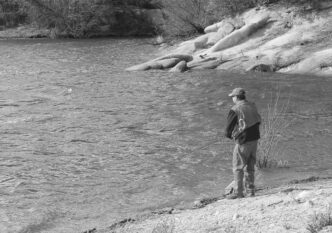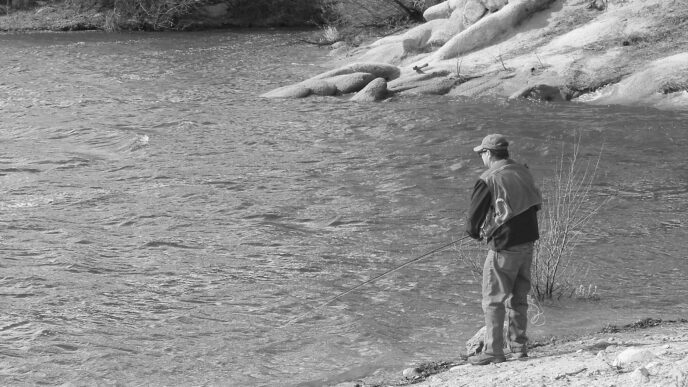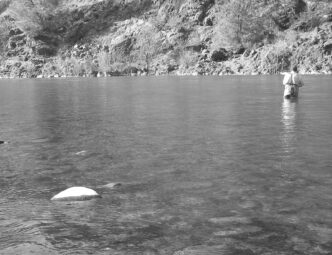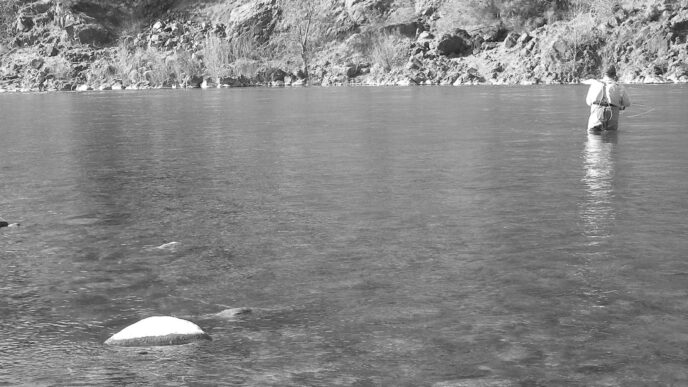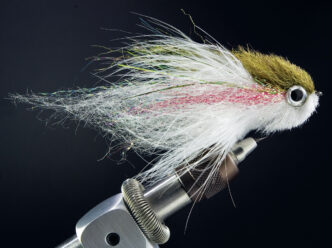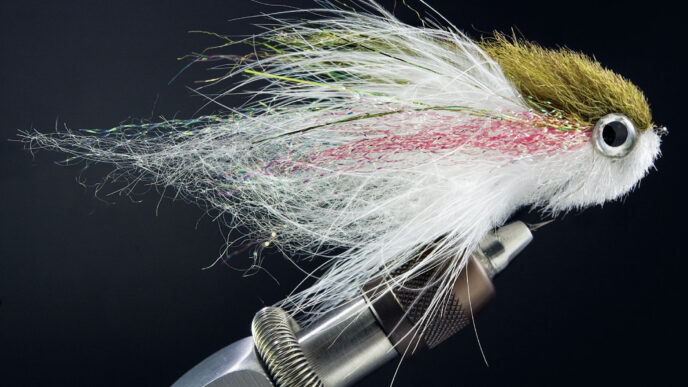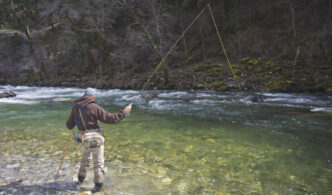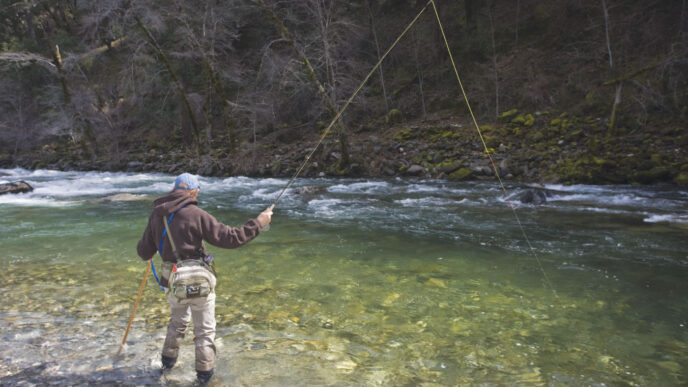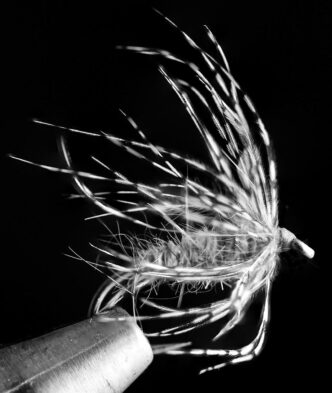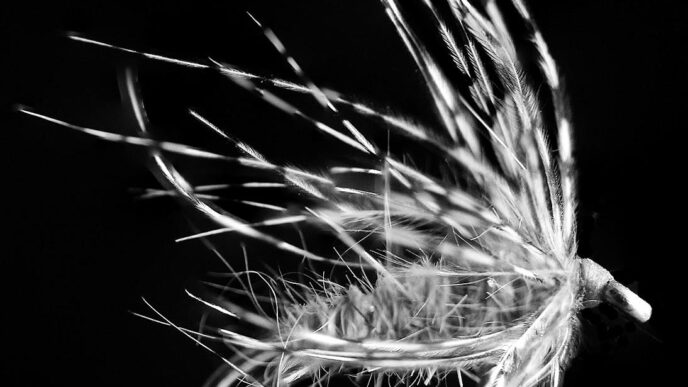In 1998, I moved from the Central Valley to Mount Shasta, a mountain community, and have learned to cherish the point in the year when I exchange my snowblower’s prime spot in the garage for the lawn mower. At about the same time, I break down my Spey and steelhead rods for storage and join the sections of my 4-weights and 5-weights, anticipating the bounty of hungry trout and the feast of hatches that the spring season brings.
The Spring Caddis
The first big hatch of the season in my area is usually what locals refer to as the “Spring Caddis” and some call the “Mother’s Day Caddis,” which typically gets going in earnest sometime in March and on most rivers in Northern California has concluded by the time Mother’s Day arrives. While many local rivers feature this hatch, the astounding numbers of this bug, the Brachycentrus caddis, that hatch on the lower Sacramento River has created a devoted following over the years. Anglers also get to enjoy watching newly arrived swallows twist and turn in flight as they partake of the feast and return to their nests on the underside of bridges to feed their young.
The variable weather in the spring can make this hatch a frustrating event on North State rivers. During cold, wet spells, there are often too few bugs to get the fish active and interested. During warm spells, the bugs hatch so prolifically that there can be too many bugs, and fish have no reason to choose your offering over the naturals. There have been spring days when I have launched my boat into thick mats of dying and dead Spring Caddises, leaving me to wonder if there is a single rainbow remaining that is not literally stuffed to the gills.
Good weather and rafts of bugs also brings out rafts of anglers. The increased fishing pressure can create situations where an imitation that other fly fishers aren’t using can make the difference between a fair day of fishing and a great day of success.
Unless the trout are actively feeding on caddis at the surface, most fly fishers instead dead drift two or three nymphs, plus split shot, under an indicator. Subsurface patterns to imitate the Spring Caddis have been around for nearly as long as trout anglers have been tying flies. Bird’s Nests in dark olive and black continue to be popular and effective, as does a simple Brown Hackle Peacock soft hackle. Gary LaFontaine’s breakthrough patterns, the Deep Sparkle Pupa and Emergent Sparkle Pupa, have been go-to flies in olive since they gained recognition in 1981 when he published his masterpiece, Caddisflies.
Famed Redding tyers Mike Mercer, Jim Pettis, and Tim Fox have contributed innovative patterns of their own. While both Mercer’s Z-Wing Caddis and Pettis’s Pulsating Caddis incorporate LaFontaine’s use of trilobal Antron yarn to simulate the trapped air in the caddis’s exoskeleton as it emerges, Pettis also uses glass beads, which when wet cause the fly to light up like a neon sign. Tim Fox achieves the same effect with a different approach by using Krystal Flash and wire ribbing on his deadly Fox Poopah, with its accurate profile and extended body. I had the good fortune of fishing some of his early prototypes as Tim refined this fly. These patterns are most effectively fished in dark olive and black or dark gray in sizes 14 to 18, depending on the hook style. Some anglers and tyers prefer longer shanked hooks in sizes 16 and 18 that better replicate the natural, while others opt for shorter shanked, heavy gauge hooks in sizes 14 and 16 that provide a wider hook gap and use stronger wire to help prevent the loss of a fish of a lifetime.
While I often enter a fly shop intent on stocking up on my favorite patterns, like most, I succumb to the persuasion of a savvy clerk or local friend to test their latest hot fly, so I was interested when my good friend from Redding, Ross Morrison, who knows the lower Sac intimately, shared his new pattern, which uses dubbing he claimed has magical qualities — Ice Dub. It is available in myriad colors that can be used to match the naturals accurately, including some “UV” colors. The magical qualities I believe are related to the material’s ability to reflect light and mimic the caddis’s gas bubbles trapped in the exoskeleton during emergence. The results were undeniable, so I picked up some of the dubbing for my personal ties.
As a guide, I also need a pattern that is quick to tie, durable, and effective. The basis of the caddis pattern I tie is what LaFontaine called his Simplified Sparkle Pupa. The simplified pattern does away with the Sparkle Pupa’s overbody and uses Ross’s picked-out Ice Dub dubbing to trap air bubbles and reflect light. I also incorporate LaFontaine’s original ostrich herl head, just as Tim Fox does, rather than the dubbing that LaFontaine suggests to commercial tyers, because I have found it to be adequately durable and more effective. I have also found that wood duck flank adds some allure to cheeks on the Deep Sparkle Pupa and as the wing on the emerger. I add a nickel or copper bead if I want some weight and an overwing of Flashabou, which serves as a strobe light to call in feeding fish. A trick that I picked up from reading Ralph Cutter’s California Fly Fisher columns is to dip the wet fly into some Dry Shake (normally used to float dry flies) to enhance the air-trapping qualities of the dubbing while nymphing. I hope you are as pleasantly impressed by the effect as I was. I will not claim that the go-to pattern I have put together is a better imitation of the natural or revolutionary in any way, or even that it works better than any of the others I’ve mentioned. It is simply a rearrangement of parts of the previous flies that I have suggested work well, combined in a formula that is enough the same as all the others to be a good imitation, yet different enough that pressured fish have not yet come to refuse it as a fake. I also vary the color and size for other caddis hatches. I suggest you take the parts of patterns you find most attractive and construct your own new hot caddisfly imitation. The results can be very satisfying.
Fishing the Spring Caddis Hatch
Perhaps as important as a good fly pattern is a good presentation for the Spring Caddis. When guides are asked “What are they eating?” they’ll often joke “A good drift.” More often than not, there is significant truth to the matter. While the vast majority of fish are taken during the Spring Caddis hatch with the standard procedure of sinking multiple flies under a dead-drifted indicator, some anglers have considerably better success than others. I have come to believe the suucessful anglers are most often the ones with superior strike detection and hook sets, particularly during the Spring Caddis hatch, because the flies and hooks are small.
Besides improving one’s drifts, strike detection, and hook sets, there a few tricks that can also lead to more success and enjoyment. Nymphing blind is essentially a prospecting game, so anglers who cover the maximum amount of productive water increase their odds exponentially. For my own fishing, I try to nymph the water systematically, starting with drifts close in and working out to a comfortable distance, with three to five drifts down each lane. If I find fish in a lane, I take a few extra drifts there, but avoid the mistake of parking on the spot. The width of the lanes I fish is determined by the water conditions and fish behavior. Rainbows in clear water that is an optimum temperature of 55 degrees and likely willing and able to move to a fly in a wider lane, say two to three feet in each direction, while in colder or off-colored water, I fish narrower lanes.
Almost everyone who fishes nymphs experiences the feel of a wrenching grab at the end of a drift as their flies lift off the bottom. Incorporating this bonus into each drift can increase the day’s catch measurably. I like to avoid stripping in as soon as my flies come tight, so the flies have a chance to lift and swing a bit, mimicking emerging caddises. I also lengthen my line on each drift so my flies lift up at a point slightly farther downstream, increasing my odds by targeting a new lie each time.
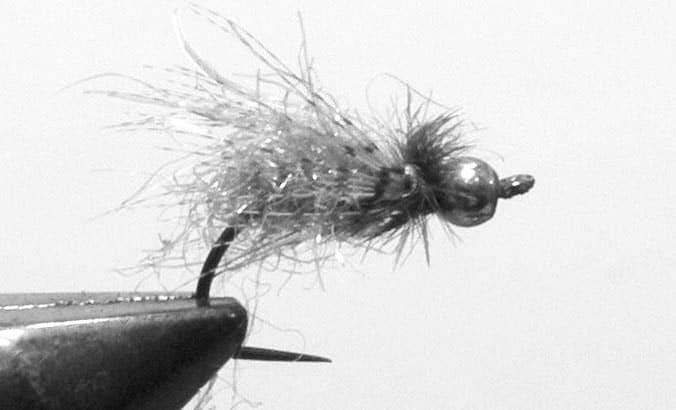
Spring Caddis
Hook: Tiemco 206 BL, size 14 to 16
Bead (optional): Copper or nickel bead
Thread: Brown 8/0 Uni-Thread
Body: Olive-brown UV Ice Dub
Wing: Wood duck flank fibers
Overwing: Pearl Flashabou
Collar: Brown or dark gray ostrich
Anglers can also change their rigging to help improve their drifts. Lower Sac veterans often replace their standard tapered leaders with a length of straight tippet — 5 to 9 feet of 2X is most common — tied directly from the indicator to the 3X or 4X tippet used to attach the upper fly in their multifly rig. They then attach split shot just above the tippet knot. This system has the advantage of less drag created by the tapered leader, so flies drift more naturally and sink more quickly and strikes get transmitted more readily. One disadvantage is that to adjust the depth at which you are fishing your flies, tippet must be added or subtracted, which cuts into the time your flies are fishing. A longtime lower Sac and Trinity guide, Jim Andras, came up with a clever solution by running his tippet through a three-inch piece of Larva Lace, which can be adjusted by sliding it up and down the 2X tippet while it serves to hold the indicator in place. Local guide Gabe Duran employs the rubber “bobber stops” used by bait casters to hold his bobbers in place.
While the majority of fish during the spring caddis hatch are caught with nymphs, do not make the mistake of overlooking opportunities to fish dry flies. I will not soon forget March 22, 2002, on the lower Sac, the best day of dry fly fishing I have enjoyed anywhere, anytime. The conditions were just right, and the fish were looking up. At one point, I hooked and landed three fish over 20 inches on consecutive casts.
If you are fortunate enough to find fish moving to the surface during a Spring Caddis hatch, understand that the fishing is most often demanding and technical. Rather than targeting fish in four to eight feet of water with nymphs, most often you’ll be casting to rising fish taking emergers on shallow flats and in tailouts, and they are easily frightened. Tippets need to be long and light — 10 feet of 5X is a good starting point — and long casts are often necessary.
I typically target one fish, doing my best to pick a large one, and observe and time its rises. My first cast is deliberately a fraction short to avoid lining the fish, because I am hoping to get it to move closer to me and the fly. I make a couple more casts, drifting the fly onto the trout’s nose, I hope without spooking it, and then I rest the fish while changing patterns and again observing the rises carefully, looking for the telltale bubbles left by fish eating on the surface or, more likely, the bulging forms left by fish taking emergers subsurface. I most often fish an Elk Hair Caddis, or, better yet, a Cutter’s E/C Caddis, with a pupa dropper tied a foot or so off the hook bend. If I fail with dries, but am able to position myself upstream from the fish, I often switch to swinging a pupa or soft hackle into its feeding lane. As when nymphing, make gentle hook sets, because the takes often test your tackle.
The Parachute Adams
If you don’t hit the spring caddis hatch, you probably have not missed the best dry-fly fishing of the season. While the peak of the mayfly hatch might be in May, several species get started as early as March and build through April into May. On local freestones such as the McCloud, upper Sacramento, and Pit Rivers, and on spring creeks such Hat Creek and the Fall River, mayfly hatches most often overlap in a dizzy parade starting with BlueWinged Olives (the Baetidae), size 16 to 20, and March Browns (Rhithrogena s.), size 12 to 14, followed not necessarily in this order by Pale Morning Duns (Ephemerella s.), size 16 to 18, and Pale Evening Duns (Ephemerella s.) size 14 to 16 (called “Sulphers” by some with East Coast roots); Green Drakes, both large, size 8 to 10 (Drunella grandis and doddsi) and small, size 12 to 14 (Drunella flavilinea), often called simply the “Flavs”; Gray Drakes (Siphlonurus occiderntalis), size 10 to 12; and Creamy Orange Duns (Serratella tibialis, size 14 to 16.
Carrying the patterns needed to cover duns, cripples, emergers, and spinners in all the necessary sizes would require a backpack full of fly boxes. Just trying to figure out which bug and which stage of the insect a fish is taking and searching through fly boxes for just the right pattern can be truly maddening. I recall one particularly memorable evening on the McCloud, surrounded by freely rising fish. At least half a dozen different bugs were hatching, yet none of the fish I cast to showed the least interest in the dozen different marvelous creations I had brought. Out of sheer frustration in the failing light, I discovered the magic of the Parachute Adams.
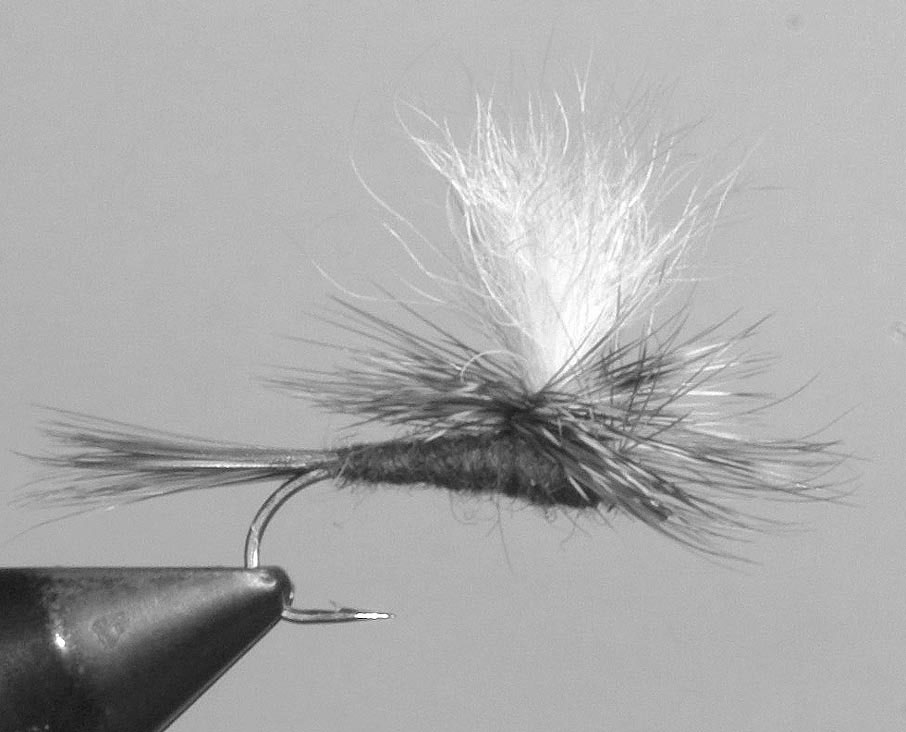
Parachute Adams
Hook: Tiemco 100, size 8 to 18
Thread: Rusty dun 6/0 or 8/0 UniThread
Tail: Mixed brown and gray hackle fibers or brown and black moose hair
Wing: White or orange calf tail post or turkey flat
Parachute Hackle: Mixed brown and grizzly
Body: Mixed Superfine Dubbing, colors achieving an overall gray-brown
My first choice is now nearly always a Parachute Adams, and I most often change sizes before I change patterns. I currently carry the fly in sizes 8 through 18. The large ones have the classic white hair wing, while on the smallest sizes, I opt for a bright wing, preferably an orange turkey flat, to aid my failing eyesight. I often tie on a soft hackle such as Bob Grace’s Soft Hackle PT (featured in my “Winter Flies” article in the January/February 2011 issue of California Fly Fisher) with a 5X or 6X dropper and fish the Adams as an attractor/indicator fly.
When tying my own Adams patterns, I try to mix several colors of dubbing together, because I believe it helps to fool trout that are being selective regarding a particular color of insect. I have been pleasantly surprised by the results, even on demanding spring creeks. On the other hand, sometimes going to the specialty box for just the right pattern does turn the trick.
The Green Drake Cripple
I like to think of the Parachute Adams as my meat-and-potatoes fly and the Green Drake Cripple as dessert, a bonbon pattern. Unlike caddisflies, which prefer warm, dry weather, mayflies hatch on overcast, drippy days, though preferably not in a hard rain. While there are occasional massive hatches of other mayflies, the Green Drakes hatch only sporadically, at best, so if I see a Green Drake or two drift or fly by, I am tempted to tie one on. The big bugs, size 8 to 12, typically drift long distances to dry their slate-colored wings before taking flight, so they make for an easy treat for trout that are looking up.
Because the Green Drake hatch is so sporadic, I have had little success trying to target it, but I am always on the lookout for them in the spring, particularly while fishing another mayfly hatch. If the trout aren’t interested in the imitations I’m fishing, I show them a Green Drake and see what happens.
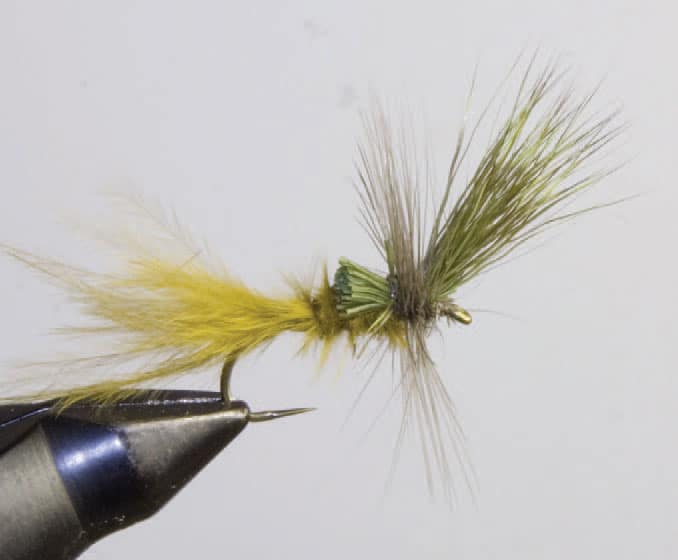
Green Drake
Hook: Tiemco 100, size 8 to 12
Thread: Olive 6/0 Uni-Thread
Tail: Olive marabou
Body: Olive marabou, wound
Wing: Olive Deer Hair Tips
Thorax: Clipped butts from deer hair wing
Hackle: Dyed olive grizzly or dark dun
For most other mayflies, I’m typically fishing at least an 11-foot leader tapered to 5X or 6X. I dead drift the flies to rising fish or target holding water using aerial mends, including bounce casts, reach mends, and curve and wiggle casts. If I raise a sizeable fish that doesn’t take, I note my position by triangulating it, measure my cast another time or two, and leave the line on the reel at the correct length for my cast. I continue fishing to other fish and then return to this exact spot. I cut my leader back a bit to 4X or 5X tippet and tie on a Green Drake. Many times, this won’t work, but on the occasions when it does, I land some of the biggest fish of the season, and it helps make me feel like a very clever fellow.
The Sofa Pillow and Foam Stone
I still have not yet discussed the truly big morsels that hatch in the spring — the stoneflies, in particular the Salmonflies (Pteronarcys californica) and Golden Stones (Calineuria californica). Hat Creek is the first place where I encountered Salmonflies, and I have gone on to chase this famed hatch across the West, including trips to the Madison, Deschutes, and Rogue Rivers and, most recently, the Klamath River. There are also fishable hatches on the McCloud and Pit, with increasing numbers showing on the upper Sacramento, because it took several years for these bugs to recover from the toxic metam sodium spill on the railroad at the Cantara Loop in 1991. Fly fishers also have been fishing stonefly nymph imitations successfully on the lower Sac for a few seasons now, as the bugs appear to be increasing in number, perhaps as a result of the new temperature-controlled releases from Shasta Dam. We are hopeful that we’ll soon see some significant dry-fly action in the upcoming years.
I discussed techniques for fishing this hatch extensively in “Seasons on the Klamath: Spring” in the May/June 2010 issue of California Fly Fisher, but a few points are worth repeating. For dry-fly fishing, it is best to target the egg-laying period, rather than the hatch itself, because that is when the fish will be looking up. The nymphs emerge on midstream rocks or crawl to shore. During the early stages of the hatch, it is best to target banks where emerged bugs fall or get blown into the river from streamside vegetation as they cling and crawl in search of mates. These big bites bring the largest fish in the river to the surface. The insects prefer the warmth of late morning and afternoon, allowing anglers to sleep in and enjoy a hearty breakfast, and they remain active into early evening, then return to streamside vegetation at dusk in time for you and your fishing partners to enjoy cocktails, dinner, and a show.
Golden Stones are more diverse than Salmonflies, with several species hatching on all but a few streams in Northern California. They typically start emerging a bit later in the season than the Salmonflies, but most often overlap a bit. Some species’ adults are a rusty or golden color, while others tend toward a bright yellow. On more than a few North State streams, some species can be found hatching well into July.
The patterns, strategies, and techniques for fishing both Salmonflies and Golden Stones are nearly identical. Adult Salmonflies and Golden Stones are best imitated with high-floating dries, sizes 4 and 6 in orange for Salmonflies and in sizes 6 to 10 in yellow or brownish gold for Golden Stones. While specific risers can be targeted on occasion, most action comes from prospecting, as when fishing with an attractor dry fly. Make a few casts to likely holding water, keep moving, and cover as much quality water as possible.
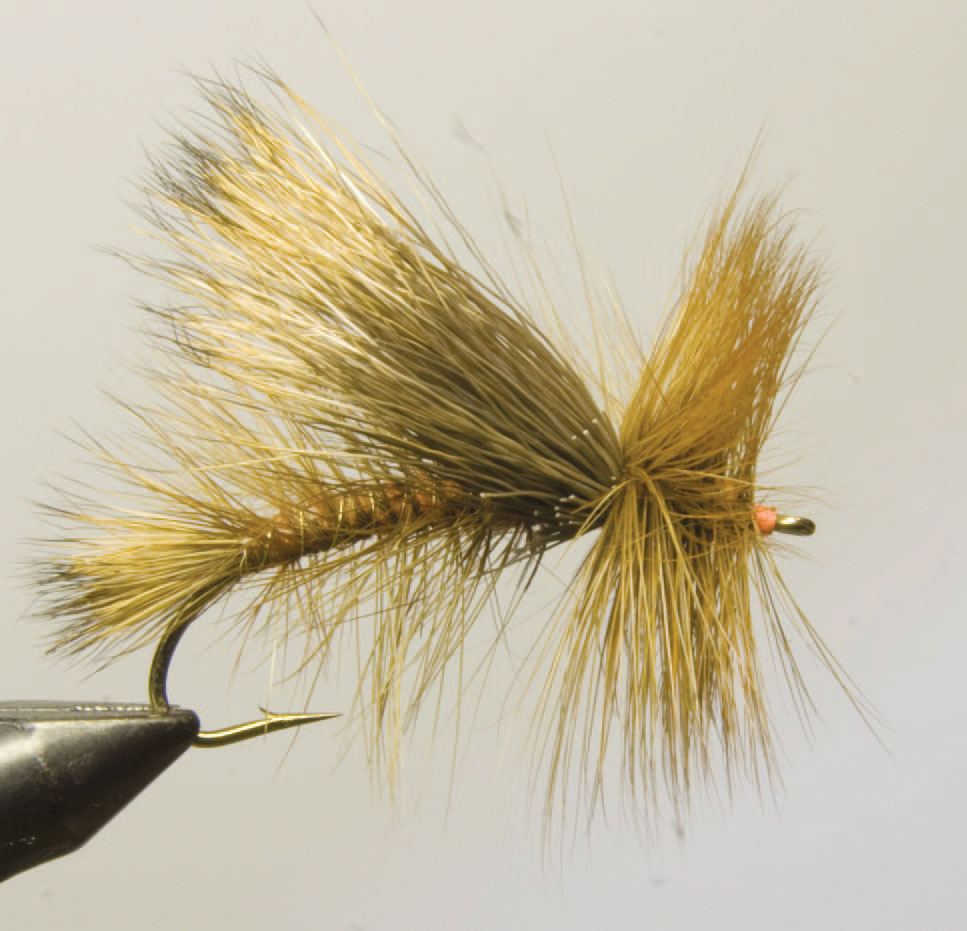
Sofa Pillow
Hook: Tiemco 5263 or 200R, size 4 to 10
Thread: Orange or yellow 6/0 UniThread
Tail: Elk hair, flared
Body Hackle: Brown, palmered up body
Body: Brown dubbing with bits of orange and yellow fibers blended in
Wing: Elk hair, flared
Front Hackle: Brown or furnace in front of wing
If the fishing is at all slow, I attach a small nymph dropper to imitate a mayfly or caddis that is hatching during the same period. Because these stonefly patterns are large and float high, they make particularly good indicator flies for a tandem of droppers fished like nymphs. I most often attach a Copper John or Ken Morrish’s Iron Sally with a small beadhead nymph hung a foot or so below it.
My two favorite stonefly patterns are the Sofa Pillow, precursor to the now more popular Kaufmann Stimulator, and the Rogue Foam Stone. I typically fish the Foam Stone in smoother flows and the fluttering Sofa Pillow in choppy, more turbulent flows. Both can be equally effective and can be purchased or tied in colors and sizes to represent both Salmonflies and Golden Stones.
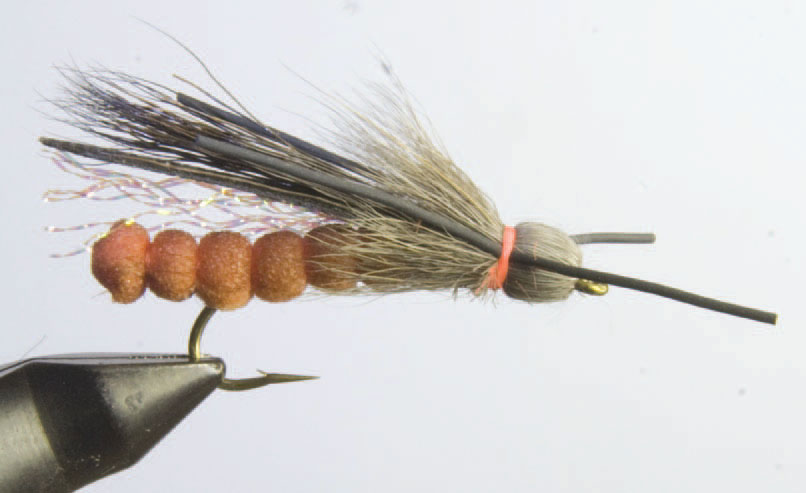
Rogue Foam Stone
Hook: Tiemco 5263 or 200R, size 4 to 10
Thread: Orange or yellow 6/0 UniThread
Body: Orange or yellow 3-millimeter closed-cell foam
Wing: Black or golden yellow Web Wing over pearl Krystal Flash
Overwing: Elk hair
Legs: Black or golden speckled rubber
Head: Black or golden deer hair






